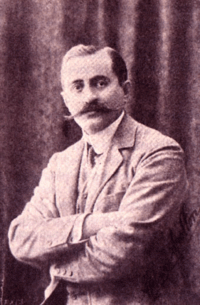Behaeddin Shakir
Behaeddin Shakir or Bahaeddin Shakir (Ottoman Turkish: بهاءالدین شاکر; Turkish: Bahattin Şakir; 1874, Constantinople (now Istanbul) – April 17, 1922) was an Ottoman politician. He was a founding member of the Committee of Union and Progress (CUP) and director of the Shuraï-Ummett, a newspaper that supported the Committee.[1] During World War I he was part of the leadership of the Teşkilât-ı Mahsusa. At the end of that war he was detained with other members of the CUP, first by a local Ottoman court martial and then by the British government. He was then sent to Malta pending military trials for crimes against humanity, which never materialized, and was subsequently exchanged by Britain for hostages held by Turkish nationalist forces.
Behaeddin Shakir | |
|---|---|
 | |
| Born | 1874 Constantinople, Ottoman Empire (now Istanbul, Turkey) |
| Died | April 17, 1922 |
| Cause of death | Assassination |
| Resting place | Neukölln cemetery |
| Nationality | Ottoman |
| Known for | Founding member of the CUP and perpetrator of the Armenian Genocide |
Armenian Genocide
Behaeddin Shakir was a central figure of the Teşkilat-i Mahsusa (Special Organization).[2] and has been described as "one of the architects of the Armenian Genocide".[3][4] This is sometimes used as proof of a state organized genocide using the tehcir (deportations) process of the Tehcir law. Halil Berktay says that local administrators objected to Behaeddin Shakir's deportation orders and called for his arrest.[5] Dissidents were usually replaced by hardliners; sometimes twice if the replacement was not pliant.[6]
In the autumn of 1919, the Armenian Revolutionary Federation (ARF) decided to punish the executors of the Armenian Genocide. Under Operation Nemesis, Aram Yerganian and Arshavir Shirakian were given the task to assassinate Cemal Azmi and Shakir who were both in Berlin. On April 17, 1922, Shirakian and Yerganian encountered Azmi and Shakir walking with their families on Uhlandstrasse street.[7] Shirakian managed to kill Azmi and wound Shakir. Yerganian immediately ran after Shakir and killed him with a shot to his head.[8][9] The assassins were never detained.
References
- McCullagh, Francis (1910). The Fall of Abd-ul-Hamid. London: Methuen & Co. Ltd. p. 19.
- Robert Kaplan (July 7, 2007). "Long history of the doctors of doom". Sydney Morning Herald. Retrieved 2008-09-03.
- Rogan, Eugene. “The Fall of the Ottomans: The Great War in the Middle East” (Basic Books, 2015) p. 174
- Mihai Andrei, "Historian unearths more solid evidence of the Armenian Genocide"
- Düzel, Neşe (2000-10-09). "Ermenileri özel örgüt öldürdü". Radikal (in Turkish). Retrieved 2008-09-03.
Osmanlı ordusu ve bürokrasisinin de bunun korkunç bir olay olduğunu algıladığını, bunları valilerden ve garnizon komutanlarından bağımsız olarak fütursuzca yapmış olan özel timlerden iğrendiğini ve hatta Enver ve Talat'ın özel adamı olan Behaeddin Shakir hakkında 1915-16 yıllarında tevkif müzekkeresi çıkaran, onu tutuklamaya çalışan valiler ve garnizon komutanlarının olduğunu görüyoruz.
- Mann, Michael (2005). The Dark Side of Democracy: Explaining Ethnic Cleansing. Cambridge University Press. p. 159.
- "Two 'Young Turks' Murdered in Berlin Assassins of Azmy Bey and Chakir Escape, but 15 Armenians Are Arrested. Financed from America German Police Say These Acts of Vengeance Have Their Inspiration Here" (PDF). New York Times. 1922-04-18. Retrieved 25 May 2013. - NYT preview page
- Berberyan, Nazaret. ՏԱՐԵԴԱՐՁՆԵՐ- Արշաւիր Շիրակեան Հայ ժողովուրդի Արդարահատոյց Բազուկը. Asbarezdate=April 13, 2010 (in Armenian). Retrieved 25 May 2013.
- Derogy, Jacques (1990). Resistance and revenge: the Armenian assassination of the Turkish leaders responsible for the 1915 massacres and deportations. Transaction Publishers. p. 61. ISBN 9781412833165.